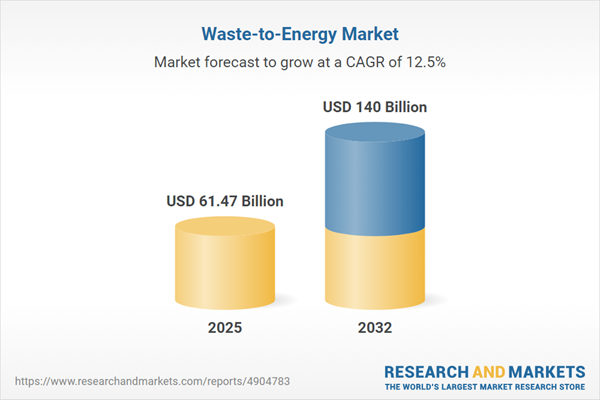Speak directly to the analyst to clarify any post sales queries you may have.
The waste-to-energy market is rapidly establishing itself as a vital lever for organizations committed to sustainable resource management, helping transform operational waste into valuable energy streams. Senior decision-makers across industries must understand evolving trends, regulatory shifts, and technology advancements that shape investments and competitive positioning in this dynamic sector.
Market Snapshot: Waste-to-Energy Market Growth and Opportunity
The waste-to-energy market grew from USD 54.70 billion in 2024 to USD 61.47 billion in 2025, with projections to reach USD 140.00 billion by 2032 at a CAGR of 12.46%. This robust growth underscores accelerating demand as organizations worldwide seek to reduce landfill dependency and tap into renewable energy sources. Regulatory imperatives, combined with the adoption of advanced thermal, biochemical, and chemical conversion pathways, are driving substantial infrastructure expansion and investment, positioning the sector as a significant force in global energy transitions.
Scope & Segmentation
- Technology Type: Incineration, pyrolysis, thermal gasification, anaerobic digestion, fermentation, chemical conversion, landfilling.
- Feedstock Type: Animal manure, crop residue, industrial waste, medical waste, commercial waste, household waste, sewage sludge.
- Plant Capacity: Large scale, medium scale, small scale facilities.
- Application: Combined heat and power, district heating, electricity generation, hydrogen production.
- End User: Commercial enterprises, industrial facilities, municipalities, local governments.
- Regions Covered: Americas (North America, Latin America), Europe, Middle East, Africa, Asia-Pacific.
- Key Companies: ANDRITZ AG, Veolia Environnement SA, SUEZ, Covanta, Hitachi Zosen Corporation, Babcock & Wilcox Enterprises, plus strategic regional and technology-focused providers.
Key Takeaways for Senior Decision-Makers
- The continued integration of advanced waste-to-energy technologies enables processing of diversified waste streams, improving project viability and expanding operational footprints.
- Innovative digital solutions, including real-time performance analytics and AI-driven optimization, are enhancing efficiency and supporting compliance with environmental reporting standards.
- Strategic partnerships between municipalities, industrial operators, and technology vendors are creating scalable deployment models, accelerating project timeframes, and optimizing capital allocation.
- Localized production and regional supply chain hubs are becoming increasingly crucial, as organizations seek to offset risk from global trade disruptions and policy shifts.
- Regulatory frameworks and public-private incentives continue to shape adoption, influencing both project financing structures and long-term sustainability roadmaps.
- Decentralized and modular waste-to-energy facility designs provide flexibility for remote or specialized applications, aligning with varied capacity needs and regional resource availability.
Assessing Tariff Impact on Supply Chains and Market Access
United States tariff measures introduced in 2025 have notably shifted global supply chain dynamics in the waste-to-energy sector. The emphasis has moved toward local equipment sourcing to reduce import-related costs and streamline project execution. Domestic manufacturers now play a more strategic role, fostering innovation clusters that bolster regional competitiveness. Organizations are adopting tariff engineering to maintain profitability, leveraging trade agreements and redesigning procurement strategies for resilience in a shifting regulatory landscape. These adjustments are reconfiguring how industry players manage both operational agility and long-term investment plans.
Methodology & Data Sources
This report applies a rigorous methodology integrating in-depth primary interviews with industry stakeholders, combined with analysis of peer-reviewed literature, technical standards, and regulatory documentation. Data triangulation across diverse sources ensures findings are robust, incorporating qualitative insights with validated quantitative metrics to deliver high-confidence market intelligence.
Why This Report Matters
- Empowers executives to align technology investments and feedstock strategies with global sustainability mandates and risk mitigation needs.
- Delivers actionable segmentation and competitor analysis, supporting effective capital allocation and portfolio optimization.
- Offers insight into regulatory, technology, and regional trends shaping growth, enabling informed strategic planning and cross-sector collaboration.
Conclusion
The waste-to-energy market is at the forefront of advancing sustainable energy and circular economy objectives. Leveraging timely intelligence from this report, organizations can navigate evolving market dynamics, secure stakeholder buy-in, and strengthen competitive positioning in the global landscape.
Additional Product Information:
- Purchase of this report includes 1 year online access with quarterly updates.
- This report can be updated on request. Please contact our Customer Experience team using the Ask a Question widget on our website.
Table of Contents
3. Executive Summary
4. Market Overview
7. Cumulative Impact of Artificial Intelligence 2025
Companies Mentioned
The companies profiled in this Waste-to-Energy market report include:- ANDRITZ AG
- Axpo Holding AG
- Arrow Ecology & Engineering Overseas Ltd.
- Babcock & Wilcox Enterprises, Inc.
- China Everbright Limited
- EQT Group
- Emery Energy Company
- Evoqua Water Technologies LLC
- Flex Energy Solutions
- Hitachi Zosen Corporation
- WSP
- Keppel Corporation Limited
- Veolia Environnement SA
- Wheelabrator Technologies Inc.
- Energos AS
- Sutco UK Ltd.
- Fortum Corporation
- Ramboll Group A/S
- MAN Energy Solutions SE
- Tana Oy
- EEW Energy from Waste GmbH
- Mitsubishi Heavy Industries, Ltd.
- JFE Engineering Corporation
- Doosan Lentjes GmbH
- Kawasaki Heavy Industries, Ltd.
- AVR Afvalverwerking BV
- Intouch Monitoring Ltd.
- Zheneng Jinjiang Environment Holding Co Ltd
- Ardian
- Viridor Limited
Table Information
| Report Attribute | Details |
|---|---|
| No. of Pages | 189 |
| Published | November 2025 |
| Forecast Period | 2025 - 2032 |
| Estimated Market Value ( USD | $ 61.47 Billion |
| Forecasted Market Value ( USD | $ 140 Billion |
| Compound Annual Growth Rate | 12.4% |
| Regions Covered | Global |
| No. of Companies Mentioned | 31 |









